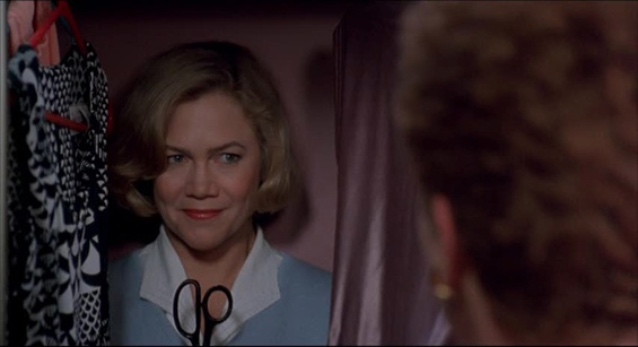
Opening on a sunlit suburban breakfast table surrounded by a stereotypical white middle-class family, John Waters’ Serial Mom (1994) proceeds to unrelentingly and hilariously skewer small-town community “values” through the story of Beverly Sutphin (Kathleen Turner), a smiling, stoic, and devoted wife and mother who dabbles in serial murder on the side. Beverly runs over her son’s math teacher with her car after the teenager (Matthew Lillard) receives a less-than-stellar grade; she stabs a studly teen bro who slights her swooning, boy-crazy daughter (Ricki Lake); she bludgeons to death a neighbour who returns rented videocassettes without rewinding them and offs another who refuses to recycle—and that’s just a few of her victims. Beverly’s engagement in recreational murder as a corrective action meant to uphold certain ideals of propriety and respectability is comically incessant and prolific. Even after she gets caught and tried in court, she continues to kill with abandon, throwing shade at a corrupt, media-thirsty justice system whose authority she refuses to recognize, firing her lawyer and defending herself with the confidence and manipulative charm of a quintessential sociopath.
To me, Serial Mom is ROFL-level funny. Some folks, however, didn’t seem to get the joke: “I am not sure why this isn’t very funny, but it’s not,” wrote Roger Ebert in his review of the film.[i] So, then, what’s the source of the humour that Ebert and others (he’s not the only one) seem to have missed?
A woman’s work is never done
First, let’s qualify “mom.” More than simply referring to a female-identified human who bears children, the term is especially prone to its broadest patriarchal, capitalist conception in Serial Mom. As the story goes, the white middle-class suburban matriarch is kempt, efficient, upright, proper, clean, perfect, and pretty damn judgmental. She’s devoted to her husband and kids, an upstanding community stalwart, a staunch policer of respectability, and definitely not employed outside the home. She’s loving but stern, prim but warm, alluring but chaste, classic but timeless. And she’s no doubt concerned more with appearances (chief among them her own) than the reality underneath. Beverly is all this and more, particularly in Turner’s performance, infused with significant wit and dynamism considering the over-the-top, on-the-nose script typical of Waters’ work, which deliberately satirizes with the heaviest of hands.
In this conception of the “mother,” we see from the very start of the film that Beverly engages in the compulsive—we might say “serial”—repetition of these qualities and acts of oppressive wife-and-mothering. She ridicules and tortures a nerdy, divorced and clumsy neighbour (Mink Stole, the cult favourite from Waters’ native Baltimore who has appeared in every single one of his films), relishing her own superior status as sophisticated, married and elegant. In a jump scare, Beverly lovingly appears at her son’s bedroom door with fresh-baked cookies, and when she spots the gory horror film he’s watching, she takes inspiration from the bloody guts splayed out on-screen for the “perfect meatloaf” she prepares later. Perhaps most fittingly, she shows the required devotion and support for her husband (Sam Waterston), a dentist, by murdering two patients of his who excessively indulge in sickly sugary sweets and don’t brush their teeth.
Although the film’s title refers to a serial killer who is also a mom (trading on the ridiculousness of pairing senseless violence with the directed nurturing of motherhood), the title also describes Beverly serially being a mom. Day in, day out, she’s a serial mom (emphasis on the second word rather than the first). In a parallel interpretation, she has turned the act of serial killing into an act of motherhood, protecting and defending her loved ones against perceived slights, keeping her community in line with best practices in respectability… all the while with not a hair out of place. In a culture that has oppressed women in a thousand ways beyond simply relegating them to the constricting box of “wife/mother,” Beverly’s serial and compulsive performance of this “traditional” role is boldly hilarious.
Beverly is hardly the only offender in Serial Mom to display stereotypical elements of seriality (compulsion, repetition, inability to desist) . In fact, Beverly’s own serial behaviour is an attempted corrective to the deviant seriality of others: her husband’s orally unhygienic patients eat sweets a little too serially; her teenage daughter chases and drools over boys quite serially, even hitting on the detective in charge of catching her mom; her son’s best friend is a serial porn watcher and compulsive masturbator; and her son and his girlfriend are perhaps the most lovable of compulsive, serial actors: they’re cinephiles. Seriality and the compulsion to repeat crass and unapologetically “low” acts (sex, porn, horror films, cake) are joyfully represented, and watching Beverly’s own sheer joy at dealing with these perceived slights through murder is nothing short of joyful itself.

The world in which Serial Mom take place is one where everyone’s unencumbered and compulsive desires are on display. If Beverly’s desires (for respectability and revenge) conflict with someone else’s (for crass impropriety), they have it out—serially. This world is one in which the “shoulds” and “shouldn’ts” with which every society grapples are laid out on the table. For example, should a juror in Beverly’s criminal trial be wearing white shoes after Labour Day? The answer, for Beverly, is absolutely not. She takes matters into her own hands and murders the woman in the hallway of the courthouse after she is acquitted of all charges—a compulsive act if there ever was one, defying the logic that one might cool one’s killing heels after the mercy of an acquittal. Beverly is a sociopathic one-woman vigilante warrior. Seriality and the compulsion to repeat even in the face of obvious danger and looming punishment? That’s funny.
But how and why does Beverly basically get away with murder?
“No woman would!”
In the conception of Beverly as serial community matriarch, mothering, like all performative identities (and, indeed, like serial killing) is a series of ostensibly instinctive repetitive and repeated steps, a series so pathological, irresistible, and compulsive that its interruption starts to seem as unlikely as preventing a sunrise. Tellingly, the film was released at the height of a kind of pop culture serial killer mania in the ‘80s and ‘90s. Differentiated from mass murder, in which multiple casualties occur in one place and time, the monstrosity of the serial killer’s work is especially horrifying because “the offender had a ‘cooling-off period’ between acts, a chance to stop and think, and yet return[s] to commit evil once again.”[ii] Even more incendiary in the discourse on serial killers during this period was the idea that they “prowled” and “passed”; that is to say, they exist among us as seemingly “normal” human beings until, at once, their inability to desist from their passions for killing activates their inner monstrosity (“[t]he vast majority of serial killers are in fact homebodies, tending to kill within one city or region, or even within a few city blocks.”[iii])
“If serial killers are compulsive and addictive,” writes Philip Jenkins in his study of the emergence of the serial killer as a cultural figure in the ‘80s and ‘90s, then “normal people exercise choice and free will. They reject and condemn substances and behaviors that can entrap them by leading them into slavish repetition… uncontrollable lusts, passions, and destructive urges that stand on the other side of the boundary.”[iv] The anxiety here (and, in Serial Mom, the platform for comedic effect) is that serial killers walk among us and do not identify themselves as such. How can one tell a serial killer from a “regular” person? Not only do they not wear visible signatures of their hidden evil, but in the popular imagination, the serial killer often “passes” among the population by virtue of their talents in manipulation, social engineering, and charisma.
Beverly, for her part, is able to get away with the majority of her crimes in the first half of the film simply because the community (and law enforcement) cannot fathom that a perfect and perfectly charming housewife could do such awful things. In the second half of the film, the town and its law enforcement officers are fully aware that Beverly is their man, but she still manages to get away with it, first by avoiding capture (in one of the funniest police car chase scenes in cinema, the small town cops cruise through a suburban tree-lined street at roughly 20 km/h after Beverly as she takes a leisurely drive to church on a Sunday morning), and then by manipulating and charming her way out of a conviction in court, trading on her nascent media celebrity, her grace, her wit and her sexuality (in an homage to Basic Instinct, she spreads her legs in court while facing a witness who is known to be a “Peeping Tom” and he immediately blubbers a retraction of his damning testimony—how fitting that Beverly pays tribute to another female serial killer in cinema who takes great joy and satisfaction from her crimes).

In one of the first gleefully abusive acts we see her perform, Beverly hides in her bedroom and makes prank calls to the uncouth divorced neighbour, threatening her with violent acts and calling her all sorts of names (“Is this the cocksucker residence?” she growls with manic joy, calling the woman “fuckface,” “pussy,” “whore” and “motherfucker,” all while barely stifling her laughter and clenching her fists with the pure joy she takes in the act). Later, when informed by law enforcement that the mysterious caller/killer utters the word “pussy,” Beverly feigns shock and assures the detectives that she has never said that word aloud. “No woman would,” reassures her husband. It’s taken as evidence that the suspect must be a man, much to Beverly’s delight.
You do you, girl / Live your best life / etc.
There’s an element of joyfulness in comedy, of course; there is deep and gratifying pleasure in uncontrollable laughter or even just a slight smile spreading across the face. But often in comedy we laugh at the on-screen character’s misfortunes, pratfalls or deadpan quips. The fact that a comedy spectator’s experience does not usually match the one on-screen is one of the reasons why Linda Williams does not include comedy in her well-known conception of “body genres”: “the reaction of the audience does not mimic the sensations experienced by the central clown.”[v] But Serial Mom comes perhaps closer than most other comedies to creating this kind of character-audience mimicry. As Beverly literally eviscerates her daughter’s unattainable crush, we cheer her on. As she grins delightedly when surprising a victim in her bedroom closet with a pair of scissors, so do we. As she takes pleasure in doing whatever the hell she wants without concern for repercussions, so do we momentarily escape into a world where doing whatever the hell one wants (and looking good doing it) is a liberating and gratifyingly consequence-free option.
Beverly’s absolute pleasure and unencumbered joy are rare in maternal protagonists in cinema (although maternal protagonists in cinema are themselves rare, period). This isn’t the internally-tortured maniacal despot of Mommie Dearest (1981) or Drop Dead Gorgeous (1999), nor is it the superhuman protective Momma Bear of Erin Brockovich (2000) or Panic Room (2002). This is a woman who (charmingly and infectiously) has gleeful adoration for being a serial mom and a serial killer, and she won’t apologize for either one. There’s an added dimension of specifically sexual pleasure, as we see Beverly delight in an autographed bodybuilding portrait of Richard Speck, photographs of Charles Manson and a magazine about Jonestown. In a final Watersian over-the-top nod to women’s sexuality and sexual pleasure, the riot grrrl band L7 performs a concert in the film wearing flesh-coloured pants that feature giant puffy labia at the crotch.

In the final victory of living her best life, Beverly is called a “feminist heroine” by Suzanne Somers, playing herself, who has been tapped to play Beverly in a biopic after her acquittal. Relishing in the media attention her crimes and her case have brought, Beverly’s self-actualization and empowerment couldn’t be more complete or more hilarious. Perhaps most affirming (and most hilarious, since it’s so discordant with dominant stereotypes) is Beverly’s total opposition to the archetype of the “monstrous-feminine” or the “abject maternal” espoused by Barbara Creed and Julia Kristeva, respectively.[vi] Far from being a source of terror, disgust, and otherness, Beverly is embraced and adored by her family and her community, even as they fear her a little in a kind of worshipful deference. No doubt this is because she checks certain boxes that preclude her total othering: she’s white, beautiful, and middle class. Still, however, the quick and easy way with which those around her accept (and celebrate) her singular, sociopathic, antisocial crime spree is not only funny but gleefully empowering. You do you, Beverly. You do you.





